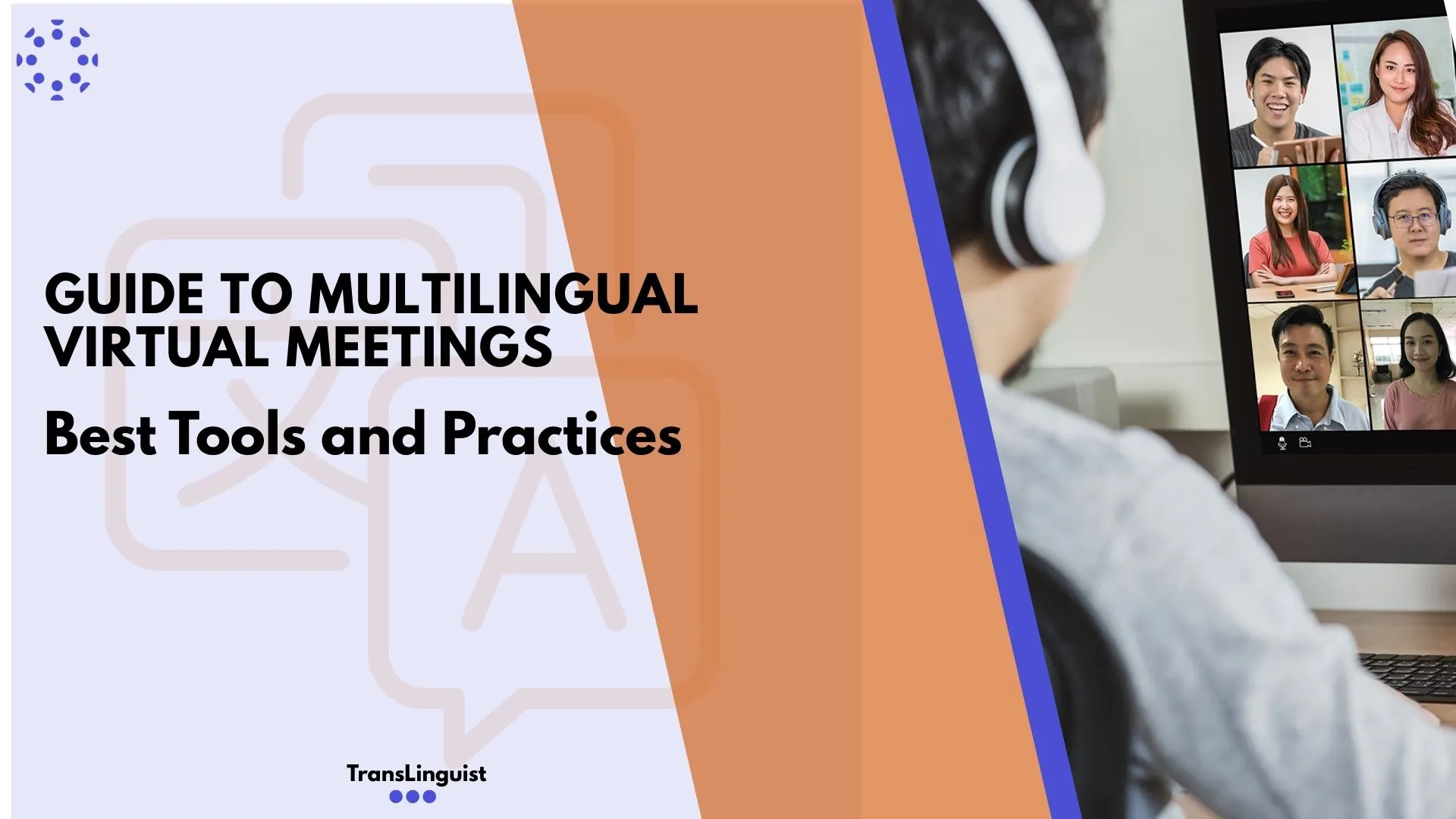Many companies may assume that anything international is simply joining a meeting link, and that may be true, but what happens when your team or client speaks different languages?
All of a sudden, a simple meeting becomes a cumbersome and frustrating exercise of attempting to go through back–and–forth interpretations of each other‘s sentences, resulting in a long and drawn-out meeting that is inefficient.
Join us as we walk you through this guide that will help you traverse the multilingual virtual meetings and events space.
Learn if your organization can implement the essential tools and best practices to make hosting multilingual meetings standard practice!
Understanding the Significance of Multilingual Meetings.
Due to the growth of international organizations as cross-border collaboration has become more mainstream, it is achievable and even necessary to communicate with international audiences in their native language.
Multilingual meetings facilitate understanding not only through obliterating the language barrier but ultimately can create greater overall understanding of its participants, all while providing every participant a spot at the table.

Imagine a scenario at a very important climate change summit: scientists from all over the globe come to share their data; however, they and their audiences all have varying degrees of fluency with many different languages – nothing more than fluency. And because of their language imitations, the conference hosts cannot have valuable exchanges in the community, or were not even able to engage at the summit. Audiences in the session may lose vital knowledge, but this time, it is because of language. This is yet another barrier that results in meaningful limitations of consensus about the work occurring at the summit, further hindering progress.
Imagine you are in a pitch meeting with a potential investor and you are unable to express your main ideas because of a language barrier. Multilingual business meetings help to access new markets and build valuable business ties with clients across national borders
The same holds for NGOs. When working with international communities and country offices, clear communication is vital for delivering essential information and building trust. With multilingual meetings, these organizations can pave the way for more effective communication.
Multilingual meetings reaching beyond language is no longer a trend. In fact, they are a must. Now that we have established the value of clear communication in virtual meetings, let’s move to the toolbox!
Essential Tools for Multilingual Meetings
Multilingual meetings aren’t just a trend anymore; in fact, they’re a necessity. Now that we’ve established the importance of clear communication during virtual meetings, let’s dive into the toolbox!
The following tools are essential in overcoming language barriers and maximizing an efficient virtual meeting setting for your meeting participants.
Identify Language Needs
First things first, before diving into the intricacies of virtual events, you need to identify the languages your participants speak. Knowing the most common language between your participants allows hosts to accurately pinpoint the meeting requirements.
Whether you’re holding multilingual business meetings with international stakeholders or a conference with global participants, conduct a quick research or survey to analyze the native language spoken by your participants.
Another thing to consider for your meeting’s interpretation services is the nature of the discussion. Is the conversation a generic update between your local offices or a complex report with technical terms? This factor, too, decides the language landscape of the meeting.
Choosing the Right Video Conferencing Platform
You have all your participants and language requirements lined up. What’s next? It’s time to decide on a multilingual meeting platform that fits your requirements.
There are some specific considerations that you should not dismiss:
- Hybrid Compatibility: Whether the platform provides remote/hybrid meetings where the interpreter stays remote while the attendees are onsite.
- Language options: Will the platform support practical language interpretation if you have deaf/hard-of-hearing participants? Can it support meetings with multiple languages?
- Scalability: How many participants does the platform’s meeting accommodate? Is it just a handful or attending hundreds?
- Integration with Third Parties: Will the platform allow for third-party video conference integration or embed other video conferencing options (Teams, Google Meet, Zoom, etc.)?
- Audio and Video Quality: Clear audio and video quality are critical for a successful multilingual meeting. Look for platforms with high-quality audiovisual capabilities, audio adjustment, and audio fallback.
- Additional Features: Multilingual meeting platforms, such as TransLinguist Interactive, simultaneously offer numerous features that can benefit organizations. Consider looking into an all-in-one platform that has Speech AI, AI-generated captions and subtitles, recordings, and meeting minutes in one place.
Language Interpretation Solutions
Ready to make the final call and select a multilingual meeting platform? Wait, there’s one last thing!
Not all platforms offer both video remote interpretation services and remote simultaneous interpretation. It is good to know the difference, and to consider what platform will meet your interpretation services needs.
- Remote Simultaneous Interpretation: In this modality, interpreters are interpreting the conversation in real-time without pauses in between. The industry standard dictates that two interpreters will operate in pairs when completing real-time interpretations. Remote simultaneous interpretation is best suited for high-paced environments with large audiences. This type of interpretation allows for a relay of constant information.
- Video Remote Interpreting: This interpreting option, also known as consecutive interpreting, is ideal for smaller groups or one-on-one encounters with a limited number of languages. The interpreter waits for the speaker to speak, stop speaking, or complete a section before interpreting.
Best Practices For Making Multilingual Meetings Better
Now that you have the tools, the next step will be to adopt the best practices that will elevate your multilingual virtual meetings.
Your organization will pave the way for clear communication and participation, and achieve meeting goals through the two activities below (despite multiple languages).
Setting the Stage for Smooth Communication
Before holding a multilingual event, it is necessary to be clear regarding the event agenda and objectives. Taking this step will define the organizing element of a pre-event summary, which therefore lays the foundation for a successful meeting.
Make sure that you’ve gathered the multilingual audience preferences. If possible, ensure that the event content and presentation material is available to all attendees in their native languages.
Secondly, familiarize your interpreters with the meeting context. In other words, provide them with relevant materials for live interpretation, including information and materials before the meeting. Besides assisting the interpreters, this allows them to accurately convey the translations, knowing the meeting context.
Lastly, it’s essential to test the audio and video equipment at your end to avoid any technical issues during the meeting. Any attendees in the meeting should be encouraged to conduct a pre-meeting audio quality and equipment test to address technical glitches beforehand.
Active Engagement and Good Communication
Hybrid events are all about creating an engaging environment where every participant feels encouraged to engage. While it can sometimes be a challenge trying to work in a multilingual, at times complicated way, you only have to put in, for example, engagement in a few steps.
First off, request the speakers to speak slowly and communicate using short sentences. This trick enables interpreters to translate the speaker efficiently. If it’s a consecutive interpretation meeting, ask the speakers to allow sufficient time for the interpreter to translate.
Don’t let your online business meetings be all talk and no show. Incorporate visuals like charts, diagrams, and images in your presentations. Additionally, utilize the screen-sharing feature to visually depict your discussion through presentations or videos to the audience.
Moderation and Etiquette Tips
In virtual gatherings, the moderator plays a foundational role in ensuring that everyone is on the same page in terms of contribution. Make sure that you keep the following points in mind during a meeting, and you’ll see a significant escalation in attendees’ satisfaction and engagement.
Encourage participation from all attendees by asking them to contribute or ask questions wherever required. Similarly, minimize background noise disruption by requesting attendees to mute their mics when they’re not actively speaking. Allow participants to raise their hands if they have any questions or type them in the chat.
Find the Right Interpreters for Your Multilingual Meetings
Want to host a successful multilingual event? It’s not just about the tools and practices, but the interpreters that make the real-time translation of hybrid events happen.
Instead of looking for interpreters by publishing projects and going through the scheduling hassle, TransLinguist Interactive offers a powerful solution: an active interpreter marketplace.
This marketplace incorporates over 4,000 professional interpreters worldwide, covering 40 languages with diverse industry-specific experience. Our global marketplace not only ensures you find an interpreter for your multilingual events but also guarantees certified, vetted interpreters that fit your needs.
Excited to learn more about this groundbreaking feature that eliminates the traditional struggles of finding interpreters? Visit TransLinguist for further details.
Final Verdict
Business meetings or online conferences, these tools and tips apply to any multilingual setting. TransLinguist Interactive is a VRI and RSI platform that enables its clients to implement cost-efficient real-time translation to any event configuration!
By using these strategies and the tools presented in this guide, you can go from turning potential obstacles into achievements in virtual meetings. So don’t allow language barriers to limit your potential globally. Unlock international opportunity and future growth through multilingual meetings!
FAQs
What are some great tips for virtual meetings?
Use Translinguist's interpretation and closed captioning services for virtual meetings so that all global participants can attend the meeting and understand the content.
Which tool is commonly used for virtual meetings?
For professional virtual meetings with multilingual support, Translinguist offers seamless video remote interpretation services to ensure clear cross-language communication.
Which product is best for use as a real-time online meeting tool across multiple participants?
Translinguist has customized platforms equipped with interpretation services specifically designed for large multilingual meetings, where communication can go smoothly with all participants.
What is a typical ground rule for virtual meetings?
A key rule is to enable Translinguist's interpretation services when hosting international meetings to maintain accuracy and professionalism across all languages.



